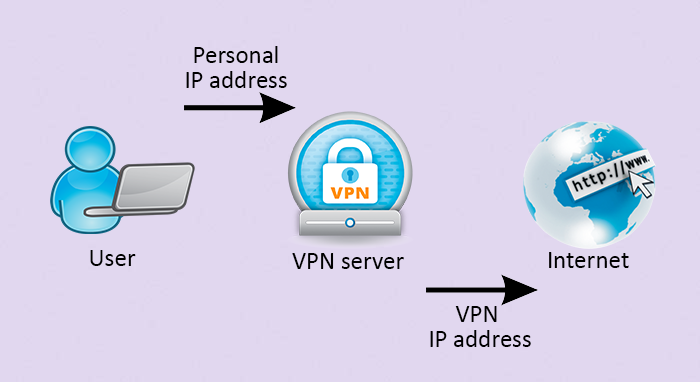The Concept of VPN
Basically, any VPN is a network tunnel that transmits data from a client to a site or some platform (and back). It works due to special encryption that can value data at the beginning of the sessions and make it the same at the end.
Also, VPN means the security of the client location (not only data protection).

The way how VPN works
There are a lot of reasons why we have to use a VPN.
- Stay anonymous on the Internet. A client can protect all his/her data from the Internet provider due to the changing of personal IP addresses.
- Circumvent geographical limitations.
- Preserve the confidentiality of information when using the unsecured Wi-Fi connection. It is a great option when you need to give an account number, various codes, and other personal data.
- Anti-hacking protection.
- Remote work in the encrypted virtual environment.
Types of VPN Protocols
There are a lot of VPN protocols that help to develop a virtual network. Each type has its own unique technical peculiarities and protection parameters.
We can list 5 of the most used protocols nowadays:
- IPSec;
- OpenVPN;
- L2TP;
- SSTP;
- PPTP.
Let’s analyze each of them separately.

Types of VPN protocols
OpenVPN
This is a special open-source protocol that is used by many VPN services today.
The product with third-party software can easily work on all the known platforms. To create an encrypted Internet connection, one should use SSL (it also checks the originality of the device).
Open VPN has perfect running speed, it is high-qualitative and secured. SSL protocol allows using a random algorithm of computer network security (for example, RSA, MD5, and RC4).
Despite the fact that product settings are quite difficult for an ordinary user, it is very easy-to-use. By the way, it is possible to configure on the base of third-party services from the Internet.
SSTP
Initially, it was designed for Windows OS. Nowadays we can use it on various platforms. Nevertheless, most part of its functionality is developed for Windows.
This protocol has a great running speed and a high level of protection. It easily works through firewalls but is vulnerable to hacking.
IPSec
ISpec is a specialized protocol of the third network level that ensure the protection before the keying on the Internet and during the transmission of IP packages.
It is a very popular product for making private VPN networks for corporate use. This protocol is effective, easy-to-use, and reasonably priced.
L2TP
It helps to make a special VPN tunnel when working with IP networks as well as with other system connections (Frame Relay, ATM, X.25). The protocol doesn’t have encryption functions. So it should be used with IPSec.
Such a combination allows making a system with double protection but clients may face the problems with performance.
PPTP
This product works on an original encryption protocol Microsoft Point-to-Point Encryption that is vulnerable, by the way. The protocol can be used by default on different devices. Also, it can be easily deployed between 2 local networks.
PPTP has a great data transfer rate. It can be used on the most popular operating platforms. Moreover, there are parameters for authentication implementation for data exchange.
Ways for VPN Connection on Mobile Devices
To connect and test VPN on a portable device, one can use the following methods:
- Select proper configuration in the phone settings. This process requires an account of any VPN service.
- Use a special program. The device will connect the VPN network by itself. Sometimes, there is no need in the user account (that makes interaction with an application much easier).
Considering default technologies of modern portable devices, anyone who possesses such a device can make a VPN network due to standard configurations.
Testing the VPN Settings on Android
So, we have a modern smartphone with Android OS. To set up the VPN configurations we’ll need to do the following:
- Go to Settings > Wireless and networks > more > VPN.
- When you open a VPN for the first time, the field will be empty. To add a network, you have to click on the + sign at the top of the screen.
- Also, when you add a VPN network first, you’ll see a message where the system asks to add a safe variant for display unlocking. Such action is required. Elsewise, a VPN connection won’t be available.
- Right after you set a method of display unlocking, you’ll see a tab for entering the information to connect the VPN network. You can choose any network name, a form of protection, give a server address and the login with a code.
- If the information is entered correctly, you’ll see “Connected” near the network name. Any Internet connection will be secured.
Testing the VPN Settings on iOS devices
The algorithm for creating and setting up the VPN network on iOS devices is the same as on Android devices:
- Go to Settings > Main > VPN.
- Click on Add New VPN Configuration. Here you have to enter the same data as on Android device. In the Remote ID field, you have to add a unique name for a VPN server that provides network services.
- When the connection is completed, you’ll see the VPN sign at the top of the screen. The connection is successful!
Use of VPN Products in Software Testing Sphere
VPN software for mobile devices can be used for different reasons. In the web product testing, such usage is confined to the following things.
To connect an intranet site or a server
Sometimes, you can get access to particular web resources only through an internal corporate network of a firm (company). With the help of a VPN, the client becomes a part of this network and hence, he/she gets full access to all the technical features.
Occasionally, clients want to make a virtual platform with authorization level and capability to deploy encrypted VPN network as well.
When QA engineers test the performance of the VPN network, they get an encryption key. With this key, testers can check a connection to the PC for correct identification and getting full access to the software structure.
Such a methodology of VPN testing is popular among a lot of companies that provide software testing services.
To get access to the blocked content
Sometimes it can happen that some web content has restrictions for selected regions, or otherwise, it can be available for all countries except for one (region of the country and so on).
In this case, a tester should check the correct system transmission through the servers that are located in the country with access to the necessary resources. And of course, all the blockings will be bypassed.
To test the software from other countries
Sometimes, a client needs to check a program from different countries all over the world (for example, because of the technical specifics of the software). In this case, he/she doesn’t need to hire QA specialists from all these countries. The client can ask a group of dedicated testers who can execute all the necessary tests through the VPN network.
Such tests involve connecting to the remote server that accepts and transmits the whole Internet traffic. QA engineer gets an external IP address of the device and technically he/she will be a user of a particular country.
Conclusion
VPN testing is one of the main parts of the security testing services when one has to certain of complete Internet anonymity. Various VPN protocols allow executing different kinds of tests for any purpose.
Nowadays, VPN testing services are one of the most popular things that clients want to have tested. And thus, they appeal to specialized companies that provide exhaustive testing of any web functionality.










0 Comments